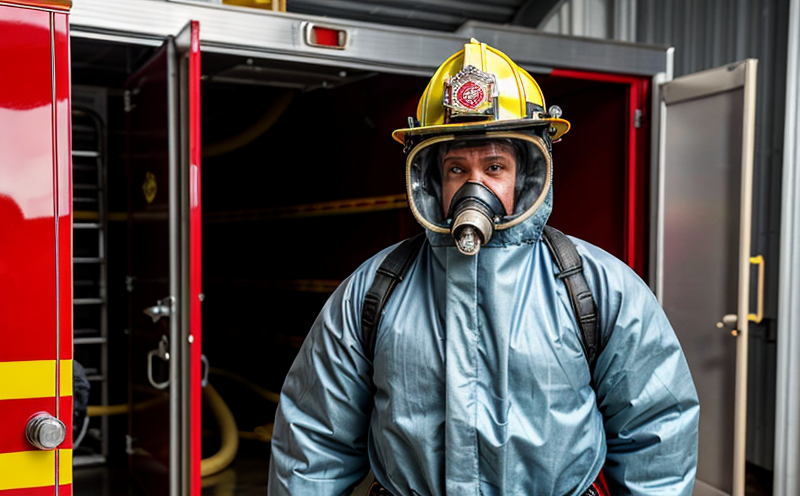Firefighter Jacket and Trouser Seam Strength Testing
In the demanding world of fire safety testing, ensuring that protective clothing meets stringent standards is paramount. Firefighter Protective Clothing & Equipment Testing encompasses a wide range of assessments designed to guarantee the durability, reliability, and performance of critical gear such as jackets and trousers used by firefighters. One crucial aspect of this testing is Seam Strength Testing for Jackets and Trousers. This service ensures that seams are capable of withstanding the physical stresses encountered during firefighting operations.
Seam integrity plays a pivotal role in protecting firefighters from hazards like heat, flames, and chemical exposure. The jacket and trousers must be constructed to prevent tears or breaches along critical stress points, such as the shoulders, armpits, and lower legs. Seam strength testing evaluates these areas using specific methodologies that simulate real-world conditions.
The test typically involves subjecting seams to a defined load until failure occurs, recording both the maximum force applied before failure and any elongation or deformation observed during the test. This data is then compared against accepted standards such as ISO 6429, which provides guidelines for determining seam strength in textile fabrics.
For jackets and trousers specifically, additional considerations include the type of fabric used (e.g., Nomex, Kevlar) and how it interacts with other materials. The testing apparatus must be capable of applying consistent tension across the width of the seam while maintaining a controlled environment that mimics environmental conditions during fire suppression activities.
The results from these tests are critical for quality managers and compliance officers ensuring that the equipment not only meets but exceeds international standards like NFPA 1971, which mandates specific seam strength requirements for protective clothing. Compliance with such regulations is essential to safeguard firefighters' lives by providing them with high-performance gear.
Testing laboratories specializing in this area utilize advanced instrumentation capable of simulating various environmental stressors and load conditions. These machines can replicate the dynamic forces exerted during rescue operations, allowing for a comprehensive evaluation of seam integrity under realistic scenarios.
The process begins with meticulous preparation of the samples according to specified protocols outlined by relevant standards organizations. This includes cleaning, conditioning, and marking test areas appropriately before placing them into the testing machine.
Once prepared, the sample is subjected to a predetermined load until it fails. Observations are made regarding any visible damage or changes in fabric properties during this process. The data collected serves as evidence supporting whether the garment meets the necessary seam strength criteria set forth by regulatory bodies.
The outcome of these tests provides vital information for R&D engineers who continually strive to improve protective clothing designs and materials. By identifying weak points or areas where improvements could be made, they can develop next-generation products that better protect firefighters while also enhancing comfort and mobility.
Understanding the importance of seam strength testing helps procurement teams make informed decisions when selecting suppliers and products for their organizations. It ensures that all issued gear adheres to strict quality control measures and maintains a high level of performance over time.
In summary, Seam Strength Testing for Firefighter Jackets and Trousers is an essential component of overall protective clothing testing services aimed at safeguarding firefighters' lives. Through rigorous evaluation processes and adherence to international standards, this service plays a crucial role in ensuring that the equipment used by these brave individuals remains reliable and effective under extreme conditions.
Why It Matters
The integrity of seams within firefighter jackets and trousers is critical for several reasons. Firstly, it ensures that the protective clothing can withstand the intense physical demands placed upon it during firefighting operations. Firefighters frequently encounter high temperatures, flames, and hazardous materials, all of which place significant stress on their gear.
Seams are particularly vulnerable to damage because they are often subjected to repeated stretching and bending motions throughout a shift. If these areas were not sufficiently strong or durable, they could potentially fail during critical moments when firefighters need maximum protection most.
Critical injuries sustained due to compromised protective clothing can have severe consequences for both the individual involved and their colleagues who rely on such gear for safety. Ensuring robust seam strength helps prevent accidents that might otherwise occur if there were even minor weaknesses present in the fabric structure.
From an organizational standpoint, maintaining high standards of protection not only enhances operational efficiency but also contributes positively to public perception regarding the dedication and professionalism of firefighting teams. When personnel feel confident that their equipment will perform as expected, they are more likely to focus on saving lives rather than worrying about potential failures.
Furthermore, compliance with recognized standards like NFPA 1971 is not just a regulatory requirement; it reflects a commitment to excellence and safety within the fire service community. By adhering to these guidelines, agencies demonstrate their dedication to upholding the highest levels of protection available for firefighters nationwide.
- Enhanced Safety: Ensures that firefighters have reliable gear capable of withstanding harsh conditions without compromising on functionality or comfort.
- Improved Performance: Allows for continuous improvement in protective clothing design by identifying areas needing enhancement through thorough testing processes.
- Increased Organizational Reputation: Demonstrates a proactive approach towards maintaining professional standards and safeguarding personnel welfare.





